晚期前列腺癌药物Xofigo(Ra 223 dichloride)
xelox方案详情
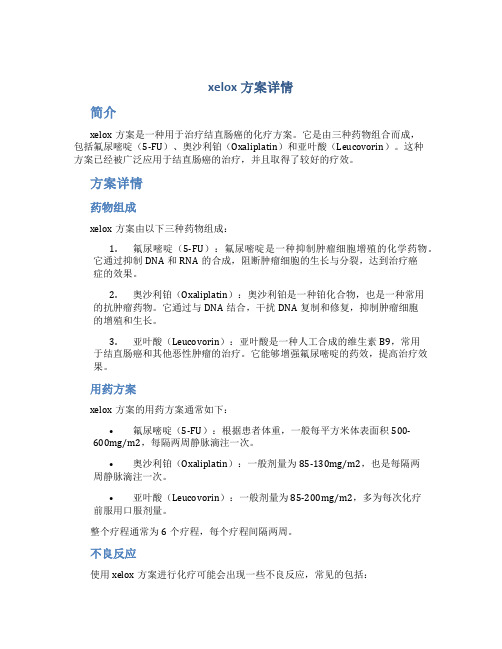
xelox方案详情简介xelox方案是一种用于治疗结直肠癌的化疗方案。
它是由三种药物组合而成,包括氟尿嘧啶(5-FU)、奥沙利铂(Oxaliplatin)和亚叶酸(Leucovorin)。
这种方案已经被广泛应用于结直肠癌的治疗,并且取得了较好的疗效。
方案详情药物组成xelox方案由以下三种药物组成:1.氟尿嘧啶(5-FU):氟尿嘧啶是一种抑制肿瘤细胞增殖的化学药物。
它通过抑制DNA和RNA的合成,阻断肿瘤细胞的生长与分裂,达到治疗癌症的效果。
2.奥沙利铂(Oxaliplatin):奥沙利铂是一种铂化合物,也是一种常用的抗肿瘤药物。
它通过与DNA结合,干扰DNA复制和修复,抑制肿瘤细胞的增殖和生长。
3.亚叶酸(Leucovorin):亚叶酸是一种人工合成的维生素B9,常用于结直肠癌和其他恶性肿瘤的治疗。
它能够增强氟尿嘧啶的药效,提高治疗效果。
用药方案xelox方案的用药方案通常如下:•氟尿嘧啶(5-FU):根据患者体重,一般每平方米体表面积500-600mg/m2,每隔两周静脉滴注一次。
•奥沙利铂(Oxaliplatin):一般剂量为85-130mg/m2,也是每隔两周静脉滴注一次。
•亚叶酸(Leucovorin):一般剂量为85-200mg/m2,多为每次化疗前服用口服剂量。
整个疗程通常为6个疗程,每个疗程间隔两周。
不良反应使用xelox方案进行化疗可能会出现一些不良反应,常见的包括:1.消化系统反应:恶心、呕吐、腹泻等。
2.外周神经系统反应:手足综合征(手脚发麻、刺痛、感觉异常等)。
3.肝功能异常。
4.血液系统反应:白细胞计数下降、贫血等。
5.过敏反应。
对于不同的患者,不良反应可能会有所不同,一些患者可能会出现更严重的不良反应,需要密切监测和处理。
疗效评估治疗完成后,通常会进行疗效评估,常用的方法包括:1.影像学检查:如CT扫描、MRI等。
2.肿瘤标志物检测:如CEA、CA19-9等。
3.结直肠镜检查。
晚期前列腺癌治疗药——Zytiga
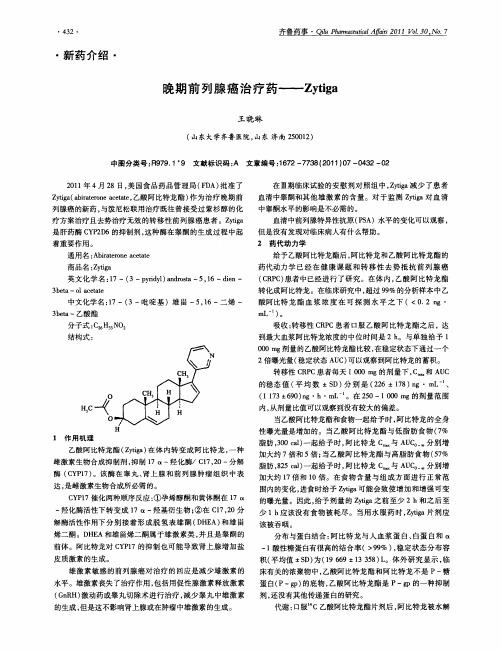
积( 平均值 ± D 为(969± 338 L S ) 1 6 1 5 ) 。体 外研究 显示 , 临 床有关 的浓聚物 中, 乙酸阿 比特龙 酯和 阿 比特龙 不是 P一 糖 蛋 白( g) P— P 的底 物 , 乙酸阿 比特 龙酯是 P g — P的一种抑制
剂 , 没有其他传递蛋 白的研究 。 还
列腺癌 的新药 , 与泼尼松联用治疗 既往 曾接受 过紫杉醇 的化 疗方案治疗且 去势治疗 无效 的转 移性前 列腺 癌患者 。Z t a yi g
在 Ⅲ期临床试验 的安慰剂 对 照组 中 ,y g 减 少 了患者 Zta i 血清 中睾酮和其 他雄 激 素的含 量 。对 于监 测 Zt a对 血清 yi g 中睾酮水平 的影 响是不 必需 的。
内, 从剂 量 比值可以观察到没有较大的偏差 。
当乙酸阿 比特龙酯 和食物一起 给予时 , 比特 龙 的全 身 阿
H
1 作 用 机 理
性曝光量是增加 的。当乙酸 阿 比特 龙酯 与低 脂肪食 物 ( % 7 脂肪 , 0c1一起 给予 时 , 比特 龙 c 与 A C 分别 增 3 a) 0 阿 U。 加大约 7倍和 5倍 ; 当乙酸 阿 比特 龙酯 与高脂 肪食 物 ( 7 5 % 脂肪 ,2 a) 8 5c1一起 给予 时 , 比特龙 c 与 A C 分别 增 阿 U。 加大 约 1 和 1 7倍 O倍。在食 物含 量与组 成 方面 进行 正 常范 围内的变化 , 进食时给予 Zt a 能会致使 增加 和增强 可变 yi 可 g
C P7 Y 1 催化两种顺序反应 : ①孕烯醇酮 和黄体酮在 1 7仪
一
羟化酶活性下转 变成 1 一 7 羟基衍 生物 ; ②在 C72 分 1 ,0
少 1 应该没有 食 物被耗 尽。 当用 水 服药 时 ,yg 片剂 应 h Zta i
FDA批准的放射性药物都有哪些?

FDA批准的放射性药物都有哪些?展开全文中华医学会核医学分会放射性药物学组整理1、药物名称:Carbon-11 choline(11C-胆碱)生产商:Mayo Clinic 商品名:—用途:前列腺癌复发诊断2、药物名称:Carbon-14 urea(14C-尿素)生产商:Kimberly-Clark 商品名:PYtest用途:胃中幽门螺杆菌感染诊断3、药物名称:Fluorine-18 florbetaben(18F-AV1)生产商:Piramal Imaging 商品名:Neuraceq™用途:阿尔茨海默(AD)患者和痴呆患者评价4、药物名称:Fluorine-18florbetapir(18F-AV45)生产商:Eli Lilly 商品名:Amyvid™用途:阿尔茨海默症诊断与治疗5、药物名称:Fluorine-18sodium fluoride(18F-氟化钠)生产商:Various 商品名:—用途:成骨能力的骨显像剂6、药物名称:Fluorine-18fludeoxyglucose(18F-FDG)生产商:Various 商品名:—用途:肿瘤、癫痫病灶糖代谢异常检测7、药物名称:Fluorine-18flutemetamol(18F-PIB)生产商:GE Healthcare 商品名:Vizamyl用途:阿尔茨海默(AD)患者和痴呆患者评价8、药物名称:Gallium-67 citrate(67Ga-柠檬酸)生产商:Lantheus MedicalImaging、Mallinckrodt商品名:—用途:霍奇金病、淋巴瘤、支气管癌以及一些急性炎症病变诊断9、药物名称:Indium-111capromab pendetide(111In-卡罗单抗喷地肽)生产商:AytuPharmaceuticals 商品名:ProstaScint®用途:前列腺癌患者、前列腺癌术后高度怀疑转移患者的检测10、药物名称:Indium-111 chloride(111In-氯化铟)生产商:GE Healthcare、Mallinckrodt 商品名:Indiclor™用途:用于放射性标记11、药物名称:Indium-111 pentetate(111In-DTPA)生产商:GE Healthcare 商品名:—用途:放射性核素脑池造影12、药物名称:Indium-111oxyquinoline(111In-羟基喹啉)生产商:GE Healthcare 商品名:—用途:用于自体白细胞标记,炎症及感染的诊断13、药物名称:Indium-111pentetreotide(111In-奥曲肽)生产商:Mallinckrodt 商品名:Octreoscan™用途:原发性和转移性内神经分泌肿瘤生长抑素受体定位14、药物名称:Iodine I-123iobenguane(123I-MIBG)生产商:GE Healthcare 商品名:AdreView™用途:原发或转移性嗜铬细胞瘤或神经母细胞瘤的辅助诊断15、药物名称:Iodine I-123 ioflupane(123I-氟潘)生产商:GE Healthcare 商品名:DaTscan™用途:对疑似帕金森症患者的评估16、药物名称:Iodine I-123sodium iodide capsules(123I-碘化钠胶囊)生产商:Cardinal Health、Mallinckrodt 商品名:—用途:甲状腺功能及形态学评价17、药物名称:Iodine I-125 humanserum albumin(125I-人血清白蛋白)生产商:IsoTex Diagnostics 商品名:Jeanatope用途:全血及血浆容量测定18、药物名称:Iodine I-125iothalamate(125I-酞酸盐)生产商:IsoT ex Diagnostics商品名:Glofil-125用途:肾小球滤过率的评价19、药物名称:Iodine I-131 humanserum albumin(131I-人血清白蛋白)生产商:IsoTex Diagnostics 商品名:Megatope用途:全血及血浆量、心脏输出、心脏及肺血容量、蛋白质周转研究、脑肿瘤定位等20、药物名称:Iodine I-131sodium iodide(131I-碘化钠)生产商:DRAXIMAGE、Mallinckrodt 商品名:HICON™用途:甲状腺疾病的诊断与治疗21、药物名称:MolybdenumMo-99 generator(钼锝发生器)生产商:GE Healthcare、Lantheus MedicalImaging、Mallinckrodt商品名:DRYTEC™、T echnelite、UltraTechneKow®DTE用途:放射性药物的制备22、药物名称:Nitrogen-13 ammonia(13N-氨水)生产商:Various 商品名:—用途:心肌灌注评价冠状动脉疾病23、药物名称:Radium-223 dichloride(223Ra-二氯化镭)生产商:Bayer HealthCarePharmaceuticalsInc. 商品名:Xofigo®用途:去势性前列腺癌治疗24、药物名称:Rubidium-82 chloride(82Ru-氯化铷)生产商:Bracco Diagnostics 商品名:Cardiogen-82®用途:心肌灌注显像剂25、药物名称:Samarium-153lexidronam(153Sm-EDTMP)生产商:Lantheus MedicalImaging 商品名:Quadramet®用途:减轻骨转移患者的疼痛26、药物名称:Strontium-89 chloride(89Sr-氯化锶)生产商:GE Healthcare商品名:MetastronTM用途:减轻骨转移患者的疼痛27、药物名称:T echnetium-99mbicisate(99mT c-ECD)生产商:Lantheus MedicalImaging 商品名:Neurolite®用途:脑卒中患者卒中的诊断与治疗28、药物名称:Technetium-99mdisofenin(99mTc-地索芬宁)生产商:Pharmalucence 商品名:Hepatolite®用途:急性胆囊炎诊断29、药物名称:Technetium-99mexametazine(99mTc-HMPAO)生产商:GE Healthcare 商品名:C eretec™用途:脑卒中患者血脑灌注、白细胞标记显像用用于腹腔感染及肠道炎症定位30、药物名称:T echnetium-99mmacroaggregatedalbumin (99mT c-MAA)生产商:DRAXIMAGE 商品名:—用途:肺灌注评价、腹静脉分流畅通性评价31、药物名称:Technetium-99mmebrofenin(99mT c-甲溴苯宁)生产商:Bracco Diagnostics、Pharmalucence 商品名:Choletec®用途:肝胆显像剂32、药物名称:Technetium-99mmedronate(99mTc-MDP)生产商:DRAXIMAGE、GE Healthcare、Pharmalucence 商品名:MDP-25、MDP Multidose用途:骨显像剂33、药物名称:Technetium-99mmertiatide(99mTc-MAG3)生产商:Mallinckrodt 商品名:TechnescanMAG3TM用途:肾动态显像34、药物名称:Technetium-99moxidronate(99mT c-HDP)生产商:Mallinckrodt 商品名:Tec hnescan™HDP用途:骨显像剂35、药物名称:Technetium-99mpentetate(99mT c-DTPA)生产商:DRAXIMAGE 商品名:—用途:脑显像、肾显像36、药物名称:T echnetium-99mpyrophosphate(99mTc-PYP)生产商:Mallinckrodt、Pharmalucence 商品名:Technescan™、PYP™用途:骨显像、心脏显像剂、血池显像剂37、药物名称:Technetium-99m redblood cells(99mT c-红细胞)生产商:Mallinckrodt 商品名:UltraTag™用途:血池造影、消化道出血定位38、药物名称:T echnetium-99msestamibi(99mTc-MIBI)生产商:Cardinal Health、DRAXIMAGE、Lantheus MedicalImaging、Mallinckrodt、Pharmalucence商品名:Cardiolite®用途:心肌灌注,用于检测缺血、评价心机功能,乳腺成像39、药物名称:Technetium-99msodium pertechnetate (99mT c-高锝酸钠)生产商:GE Healthcare、Lantheus MedicalImaging、Mallinckrodt商品名:—用途:脑显像、甲状腺显像、胎盘定位、膀胱显像等40、药物名称:Technetium-99msuccimer(99mT c-DMSA)生产商:GE Healthcare 商品名:—用途:肾显像41、药物名称:Technetium-99msulfur colloid(99mT c-硫胶体)生产商:Pharmalucence 商品名:—用途:肝、脾、骨髓显像等42、药物名称:Technetium-99mtetrofosmin(99mTc-替曲膦)生产商:GE Healthcare 商品名:MyoviewTM用途:心肌灌注剂43、药物名称:Technetium-99mtilmanocept(99mTc-替马诺噻)生产商:NavideaBiopharmaceuticals,Inc. 商品名:Lymphoseek®用途:淋巴结定位44、药物名称:Thallium-201chloride(201Tl-氯化铊)生产商:GE Healthcare、Lantheus MedicalImaging、Mallinckrodt商品名:—用途:心肌灌注显像45、药物名称:Xenon-133 gas(133Xe气体)生产商:Lantheus MedicalImaging 商品名:—用途:肺功能评估与肺显像、脑血流评估46、药物名称:Yttrium-90chloride(90Y-氯化钇)生产商:MDS Nordion、Eckert&ZieglerNuclitec商品名:—用途:放射性标记47、药物名称:Yttrium-90ibritumomab tiuxetan(90Y-替伊莫单抗)生产商:SpectrumPharmaceuticals商品名:Zevalin®用途:非霍奇金氏淋巴瘤治疗截止至2015年8月1日。
Xofigo 放射性治疗药剂指南说明书
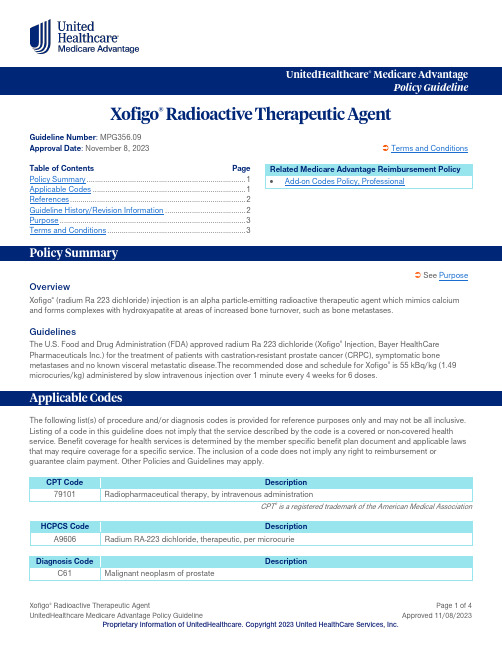
UnitedHealthcare ® Medicare AdvantagePolicy GuidelineXofigo ® Radioactive Therapeutic AgentGuideline Number : MPG356.09Approval Date : November 8, 2023 Terms and ConditionsTable of Contents Page Policy Summary ............................................................................. 1 Applicable Codes .......................................................................... 1 References ..................................................................................... 2 Guideline History/Revision Information ....................................... 2 Purpose .......................................................................................... 3 Terms and Conditions . (3)See PurposeOverviewXofigo ® (radium Ra 223 dichloride) injection is an alpha particle-emitting radioactive therapeutic agent which mimics calcium and forms complexes with hydroxyapatite at areas of increased bone turnover, such as bone metastases.GuidelinesThe U.S. Food and Drug Administration (FDA) approved radium Ra 223 dichloride (Xofigo ® Injection, Bayer HealthCare Pharmaceuticals Inc.) for the treatment of patients with castration-resistant prostate cancer (CRPC), symptomatic bonemetastases and no known visceral metastatic disease.The recommended dose and schedule for Xofigo ® is 55 kBq/kg (1.49 microcuries/kg) administered by slow intravenous injection over 1 minute every 4 weeks for 6 doses.The following list(s) of procedure and/or diagnosis codes is provided for reference purposes only and may not be all inclusive. Listing of a code in this guideline does not imply that the service described by the code is a covered or non-covered health service. Benefit coverage for health services is determined by the member specific benefit plan document and applicable laws that may require coverage for a specific service. The inclusion of a code does not imply any right to reimbursement or guarantee claim payment. Other Policies and Guidelines may apply.CPT Code Description 79101 Radiopharmaceutical therapy, by intravenous administrationCPT ® is a registered trademark of the American Medical AssociationHCPCS Code DescriptionA9606 Radium RA-223 dichloride, therapeutic, per microcurieDiagnosis Code DescriptionC61Malignant neoplasm of prostateRelated Medicare Advantage Reimbursement Policy • Add-on Codes Policy, ProfessionalDiagnosis CodeDescriptionAnd at least one of the following:C79.51 Secondary malignant neoplasm of boneC79.52 Secondary malignant neoplasm of bone marrowCMS Local Coverage Determinations (LCDs) and ArticlesLCDArticleContractor Medicare Part A Medicare Part BN/A A54559 Billing and Coding: Xofigo Billing Instructions PalmettoAL, GA, NC, SC,TN, VA, WV N/AA55052 Billing and Coding: Radiopharmaceutical Agents Retired 12/29/2022WPSAK, AL, AR, AZ, CA, CO, CT, DE, FL, GA, HI, IA, ID, IL, IN, KS, KY, LA, MA, MD, ME, MI, MO, MS, MT, NC, ND, NE, NH, NJ, NM, NV, OH, OK, OR, PA, RI, SC, SD, TN, TX, UT, VA, VT, WA, WI, WV, WYIA, IN, KS, MI, MO, NECMS Benefit Policy ManualChapter 15; § 50 Drugs and BiologicalsCMS Claims Processing ManualChapter 12; § 30.5 Payment for Codes for Chemotherapy Administration and Nonchemotherapy Injections and Infusions Chapter 14; § 10 General Ambulatory Surgical CenterChapter 17; § 90.2 Drugs, Biologicals, and RadiopharmaceuticalsOther(s)CGS Website (Submitting Claims for Xofigo/Radium 223)CMS HCPCS Codes for which ASP Reporting is in Units of Measure Other Than an NDC, Updated July 2023, CMS Website Xofigo Package Insert, Bayer Healthcare Pharmaceuticals WebsiteRevisions to this summary document do not in any way modify the requirement that services be provided and documented in accordance with the Medicare guidelines in effect on the date of service in question.Date Summary of Changes11/08/2023Policy Summary OverviewRemoved and relocated language pertaining to the U.S. Food and Drug Administration (FDA)approval of radium Ra 223 dichloride (Xofigo ® Injection, Bayer HealthCare Pharmaceuticals Inc.) usage (refer to the Guidelines section) GuidelinesRevised language to indicate:Date Summary of Changeso The U.S. Food and Drug Administration (FDA) approved radium Ra 223 dichloride (Xofigo®Injection, Bayer HealthCare Pharmaceuticals Inc.) for the treatment of patients with castration-resistant prostate cancer (CRPC), symptomatic bone metastases and no known visceralmetastatic diseaseo The recommended dose and schedule for Xofigo® is 55 kBq/kg (1.49 microcuries/kg)administered by slow intravenous injection over 1 minute every 4 weeks for 6 dosesSupporting InformationUpdated References section to reflect the most current informationArchived previous policy version MPG356.08The Medicare Advantage Policy Guideline documents are generally used to support UnitedHealthcare Medicare Advantage claims processing activities and facilitate providers’ submission of accurate claims for the specified services. The document can be used as a guide to help determine applicable:Medicare coding or billing requirements, and/orMedical necessity coverage guidelines; including documentation requirements.UnitedHealthcare follows Medicare guidelines such as NCDs, LCDs, LCAs, and other Medicare manuals for the purposes of determining coverage. It is expected providers retain or have access to appropriate documentation when requested to support coverage. Please utilize the links in the References section above to view the Medicare source materials used to develop this resource document. This document is not a replacement for the Medicare source materials that outline Medicare coverage requirements. Where there is a conflict between this document and Medicare source materials, the Medicare source materials will apply.The Medicare Advantage Policy Guidelines are applicable to UnitedHealthcare Medicare Advantage Plans offered by UnitedHealthcare and its affiliates.These Policy Guidelines are provided for informational purposes, and do not constitute medical advice. Treating physicians and healthcare providers are solely responsible for determining what care to provide to their patients. Members should always consult their physician before making any decisions about medical care.Benefit coverage for health services is determined by the member specific benefit plan document* and applicable laws that may require coverage for a specific service. The member specific benefit plan document identifies which services are covered, which are excluded, and which are subject to limitations. In the event of a conflict, the member specific benefit plan document supersedes the Medicare Advantage Policy Guidelines.Medicare Advantage Policy Guidelines are developed as needed, are regularly reviewed and updated, and are subject to change. They represent a portion of the resources used to support UnitedHealthcare coverage decision making. UnitedHealthcare may modify these Policy Guidelines at any time by publishing a new version of the policy on this website. Medicare source materials used to develop these guidelines include, but are not limited to, CMS National Coverage Determinations (NCDs), Local Coverage Determinations (LCDs), Medicare Benefit Policy Manual, Medicare Claims Processing Manual, Medicare Program Integrity Manual, Medicare Managed Care Manual, etc. The information presented in the Medicare Advantage Policy Guidelines is believed to be accurate and current as of the date of publication and is provided on an "AS IS" basis. Where there is a conflict between this document and Medicare source materials, the Medicare source materials will apply.You are responsible for submission of accurate claims. Medicare Advantage Policy Guidelines are intended to ensure that coverage decisions are made accurately based on the code or codes that correctly describe the health care services provided. UnitedHealthcare Medicare Advantage Policy Guidelines use Current Procedural Terminology (CPT®), Centers for Medicare andMedicaid Services (CMS), or other coding guidelines. References to CPT® or other sources are for definitional purposes only and do not imply any right to reimbursement or guarantee claims payment.Medicare Advantage Policy Guidelines are the property of UnitedHealthcare. Unauthorized copying, use, and distribution of this information are strictly prohibited.*For more information on a specific member's benefit coverage, please call the customer service number on the back of the member ID card or refer to the Administrative Guide.。
吃“索拉菲尼”的一些经验
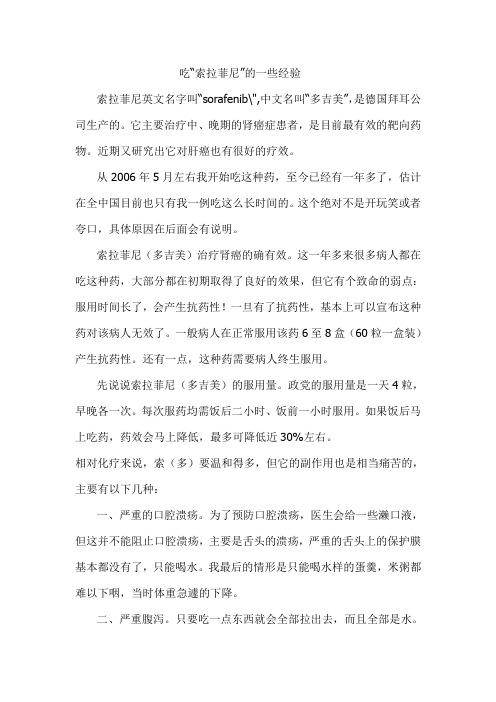
吃“索拉菲尼”的一些经验索拉菲尼英文名字叫“sorafenib\",中文名叫“多吉美”,是德国拜耳公司生产的。
它主要治疗中、晚期的肾癌症患者,是目前最有效的靶向药物。
近期又研究出它对肝癌也有很好的疗效。
从2006年5月左右我开始吃这种药,至今已经有一年多了,估计在全中国目前也只有我一例吃这么长时间的。
这个绝对不是开玩笑或者夸口,具体原因在后面会有说明。
索拉菲尼(多吉美)治疗肾癌的确有效。
这一年多来很多病人都在吃这种药,大部分都在初期取得了良好的效果,但它有个致命的弱点:服用时间长了,会产生抗药性!一旦有了抗药性,基本上可以宣布这种药对该病人无效了。
一般病人在正常服用该药6至8盒(60粒一盒装)产生抗药性。
还有一点,这种药需要病人终生服用。
先说说索拉菲尼(多吉美)的服用量。
政党的服用量是一天4粒,早晚各一次。
每次服药均需饭后二小时、饭前一小时服用。
如果饭后马上吃药,药效会马上降低,最多可降低近30%左右。
相对化疗来说,索(多)要温和得多,但它的副作用也是相当痛苦的,主要有以下几种:一、严重的口腔溃疡。
为了预防口腔溃疡,医生会给一些濑口液,但这并不能阻止口腔溃疡,主要是舌头的溃疡,严重的舌头上的保护膜基本都没有了,只能喝水。
我最后的情形是只能喝水样的蛋羹,米粥都难以下咽,当时体重急遽的下降。
二、严重腹泻。
只要吃一点东西就会全部拉出去,而且全部是水。
到后期每次去厕所都会心理斗争,因为不但腹内绞痛,而且屁股跟刀割一样的痛。
即使上完厕所,躺在床上还会痛一会儿。
医生说无论是上、下,包括肠内,都有粘膜溃疡,所以才会痛。
三、手足症。
药吃上一、二个星期,各种副作用开始出现,手足症也随之而来。
手、脚上尤其关节部位会先发红,这时就开始有点痛了,慢慢的变成了角质样的黄色,一块块的,不能碰,一碰就会痛。
这时候走路开始有点跛了,手也不好使了,不敢抓东西。
如果停药了,它会慢慢变成硬皮脱落下来,手、脚又恢复如初。
对我来说最要命的就是这三种症状。
比卡鲁胺胶囊简介和使用说明书

比卡鲁胺胶囊简介和使用说明书比卡鲁胺胶囊(岩列舒)是用于晚期前列腺癌内分泌治疗的常用药物,通过抑制雄激素的分泌,切断肿瘤生长的动力,达到抑制抑制癌肿发展的目的。
前列腺癌是激素依赖型肿瘤,降低雄激素能抑制癌肿的发展。
比卡鲁胺胶囊(岩列舒)可用于睾丸切除术后治疗,提高抗癌效果,抑制癌细胞转移。
【药品名称】通用名:比卡鲁胺胶囊商品名称:岩列舒【英文名】Bicalutamide Capsules【汉语拼音】Bikalu'an Jiaonang【成分】比卡鲁胺化学名称:比卡鲁胺分子式:C18H14N2O4F4S【适应症】与促黄体生成素释放激素(LHRH)类似物或外科睾丸切除术联合应用于晚期前列腺癌的治疗。
【用法用量】成年男性包括老年人:一粒(50mg),一天一次,用本品治疗应与LHRH类似物或外科睾丸切除术治疗同时开始,本品禁用于儿童。
另外,中重度肝损伤的患者可能发生药物蓄积(详见注意事项)。
【不良反应】本品的药理作用可以引起某些预期的反应,包括面色潮红、搔痒、另外乳房触痛和男性乳房女性化,它可随睾丸切除术减轻。
本品也可能引起腹泻、恶心、呕吐、乏力和皮肤干燥。
肝功改变(转氨酶水平升高,黄疸)已经在本品的临床试验中被观察到,但少见严重变化,这种改变常常是短暂的。
无论是继续治疗还是随即中止治疗均可逐渐消退或改善,服用本品极少出现肝功能衰竭,应考虑定期查肝功能。
在使用本品与LHRH类似物伍用进行临床研究期间还观察到下列副作用(临床试验者认为可能与药物相关且发生率大于1%)。
这些副作用与药物的使用没有因果关系,有些是老年人日常固有的。
心血管系统:心衰。
消化系统:厌食、口干、消化不良、便秘、胃肠胀气。
中枢神经系统:头晕、失眠、嗜睡、性欲减低。
呼吸系统:呼吸困难。
泌尿生殖系统:阳痿、夜尿增多。
血液学:贫血。
皮肤及其附件:脱发、皮疹、出汗、多毛。
代谢及营养:糖尿病、高血糖、周围性水肿、体重增加、体重减轻。
躯干:腹痛、胸痛、头痛、骨盆痛、寒战。
诺雷得说明书

诺雷德(戈舍瑞林)是激素制剂,能调控体内性激素的水平,它既可以抑制雄性激素的释放,也可以抑制雌激素的释放,因此和激素调节有关的前列腺癌,乳腺癌等恶性肿瘤选用诺雷德治疗能起到很好的效果。
临床研究发现,诺雷德不仅能抗癌,而且还能对抗男性前列腺增生和女性子宫内膜异位。
诺雷德是一种缓释制剂,具有长达28天的疗效,这一点更是扩大了诺雷德的临床应用。
诺雷德(戈舍瑞林)适应症诺雷德适应用于前列腺癌的治疗。
诺雷德用于前列腺癌的治疗有三种方案。
1. 诺雷德作为一线用药直接发挥作用。
诺雷德可以作为治疗前列腺癌的直接用药。
诺雷德被人体吸收后能抑制脑垂体释放睾丸素,从而引起男性血清睾丸酮的下降,减少雄性激素对前列腺癌的刺激,导致前列腺癌瘤体缩小,改善排尿苦难症状。
诺雷德治疗前列腺癌使用剂量为 3.6mg,注射埋植,每28日1次2. 诺雷德可以和岩列舒联合用药治疗前列腺癌。
诺雷德和岩列舒联合用药能增强诺雷德的抗癌效果,同时还能减轻畐怖用。
3. 诺雷德用于前列腺癌放化疗后。
临床研究表明,放化疗后服用诺雷德能减轻放化疗的副作用,同时还能增强放化疗的效果。
诺雷德用于乳腺癌的治疗。
乳腺癌的形成和雌二醇的浓度有很大的关系。
服用诺雷德后能降低体内雌二醇的浓度,减少雌激素对乳腺癌的刺激作用,大致瘤体缩小。
诺雷德用于前列腺增生的治疗。
对于那些暂不宜手术或对手术有顾虑的老年前列腺增生患者来说,选用诺雷德治疗疗效好,见效快,毒副作用小。
诺雷德用于治疗子宫内膜异位。
诺雷德能缓解子宫内膜异位的疼痛症状,同时,服用诺雷德还能减少子宫内膜损伤的大小和数目,治疗这种疾病诺雷德的疗程是6个月。
诺雷德的药理作用男性血清睾酮和女性血清雌二醇都属于性激素的范畴,在它们的刺激下,男性的前列腺癌,女性的乳腺癌,卵巢癌,子宫肌瘤等都会快速增长,恶化。
而这两种激素的生成和促黄体生成激素有很大的关系。
诺雷德的化学结够和促黄体生成素释放激素相类似。
如果长期使用会抑制垂体的促黄体生成激素的分泌。
Xofigo(雷达 Ra 223 二氧化钙)使用指南说明书
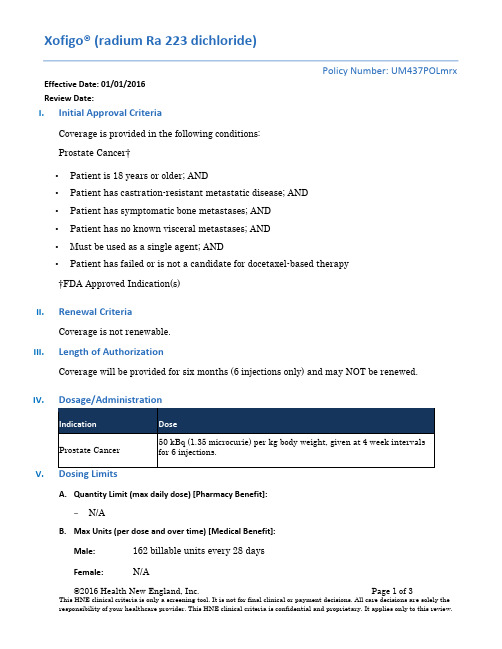
Xofigo® (radium Ra 223 dichloride)Policy Number: UM437POLmrx Effective Date: 01/01/2016Review Date:I.Initial Approval CriteriaCoverage is provided in the following conditions:Prostate Cancer†•Patient is 18 years or older; AND•Patient has castration-resistant metastatic disease; AND•Patient has symptomatic bone metastases; AND•Patient has no known visceral metastases; AND•Must be used as a single agent; AND•Patient has failed or is not a candidate for docetaxel-based therapy†FDA Approved Indic ation(s)II.Renewal CriteriaCoverage is not renewable.III.Length of AuthorizationCoverage will be provided for six months (6 injections only) and may NOT be renewed.IV.V.A.Quantity Limit (max daily dose) [Pharmacy Benefit]:−N/AB.Max Units (per dose and over time) [Medical Benefit]:Male: 162 billable units every 28 daysFemale:N/AVI.Billing Code/Availability InformationJcode:A9606* – Xofigo (Bayer HealthCare) Radium Ra-223 dichloride, therapeutic: 1 billable unit = 1 microcurie *effective 1/1/2015NDC:N/AVII.References1.Xofigo [package insert]. Wayne, NJ; Bayer HealthCare; May 2013. Accessed July 2015.2.Referenced with permission from the NCCN Drugs & Biologics Compendium (NCCNCompendium®) for Prostate Cancer 1.2015. National Comprehensive Cancer Network,2015. The NCCN Compendium® is a derivative work of the NCCN Guidelines®. NATIONALCOMPREHENSIVE CANCER NETWORK®, NCCN®, and NCCN GUIDELINES® aretrademarks owned by the National Comprehensive Cancer Network, Inc.” To view the mostrecent and complete version of the Compendium, go online to . Accessed July2015.3.Wisconsin Physicians Service Insurance Corporation. Local Coverage Determination (LCD)for Drugs and Biologicals: Chemotherapy Drugs and their Adjuncts (L28576). Centers forMedicare & Medicaid Services, Inc. Updated on 07/01/2015 with effective date 07/01/2015.Accessed July 2015.Appendix 2 – Centers for Medicare and Medicaid Services (CMS)Medicare coverage for outpatient (Part B) drugs is outlined in the Medicare Benefit Policy Manual (Pub. 100-2), Chapter 15, §50 Drugs and Biologicals. In addition, National Coverage Determination (NCD) and Local Coverage Determinations (LCDs) may exist and compliance with these policies is required where applicable. They can be found at:/medicarecoverage-database/search/advanced-search.aspx. Additional indications may be covered at the discretion of the health plan.。
晚期前列腺癌治疗药醋酸阿比特龙综述
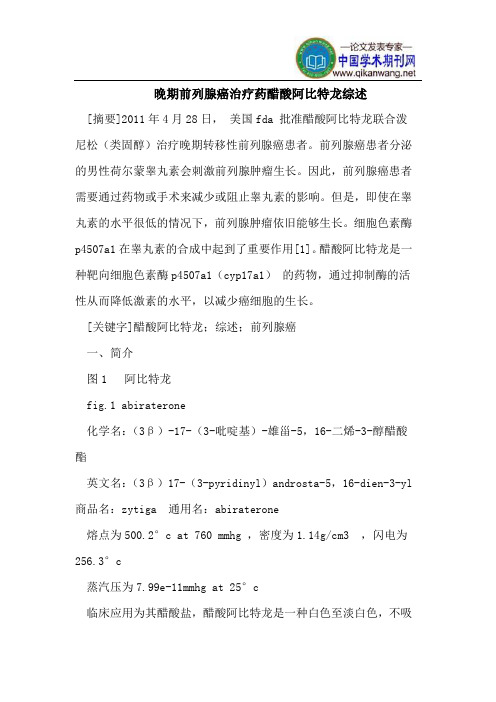
晚期前列腺癌治疗药醋酸阿比特龙综述[摘要]2011年4月28日,美国fda 批准醋酸阿比特龙联合泼尼松(类固醇)治疗晚期转移性前列腺癌患者。
前列腺癌患者分泌的男性荷尔蒙睾丸素会刺激前列腺肿瘤生长。
因此,前列腺癌患者需要通过药物或手术来减少或阻止睾丸素的影响。
但是,即使在睾丸素的水平很低的情况下,前列腺肿瘤依旧能够生长。
细胞色素酶p4507a1在睾丸素的合成中起到了重要作用[1]。
醋酸阿比特龙是一种靶向细胞色素酶p4507a1(cyp17a1)的药物,通过抑制酶的活性从而降低激素的水平,以减少癌细胞的生长。
[关键字]醋酸阿比特龙;综述;前列腺癌一、简介图1 阿比特龙fig.1 abiraterone化学名:(3β)-17-(3-吡啶基)-雄甾-5,16-二烯-3-醇醋酸酯英文名:(3β)17-(3-pyridinyl)androsta-5,16-dien-3-yl 商品名:zytiga 通用名:abiraterone熔点为500.2°c at 760 mmhg ,密度为1.14g/cm3 ,闪电为256.3°c蒸汽压为7.99e-11mmhg at 25°c临床应用为其醋酸盐,醋酸阿比特龙是一种白色至淡白色,不吸潮,结晶粉。
二、合成路线图2 阿比特龙的合成路线fig.2 the synthesis of abiraterone此合成路线经过了酮与肼的亲核加成反应,消除反应,取代反应,酯化反应生成了阿比特龙。
三、作用机制阿比特龙的作用机制是抑制17α-羟化酶/c17,20-裂解酶(cyp17a1),这是一种表达在睾丸,肾上腺,和前列腺肿瘤组织的酶。
cyp17的两个催化连续反应:(一)转换孕烯醇酮和孕酮的17 -α-羟基衍生物的17α-羟化酶活性,和(二)后形成的脱氢表雄酮(dhea)和雄烯二酮,尤其是其c17,20裂解酶的活动[2]脱氢表雄酮、雄烯二酮是雄激素和前体睾酮。
多菲戈中国上市!前列腺癌骨转移患者的福音
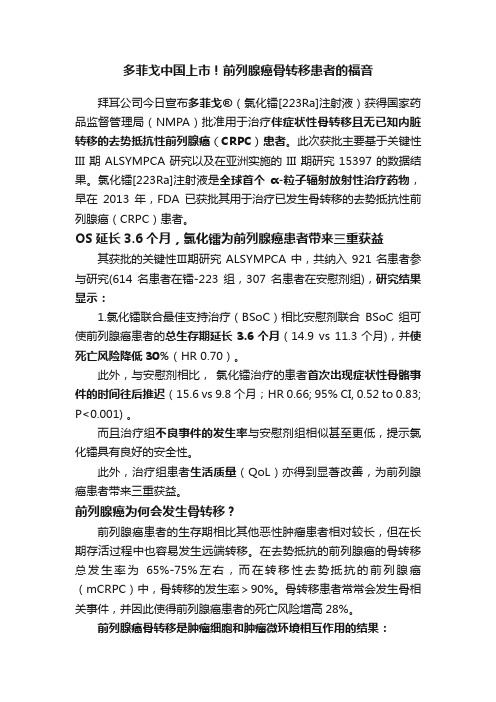
多菲戈中国上市!前列腺癌骨转移患者的福音拜耳公司今日宣布多菲戈®(氯化镭[223Ra]注射液)获得国家药品监督管理局(NMPA)批准用于治疗伴症状性骨转移且无已知内脏转移的去势抵抗性前列腺癌(CRPC)患者。
此次获批主要基于关键性III期ALSYMPCA研究以及在亚洲实施的III期研究15397的数据结果。
氯化镭[223Ra]注射液是全球首个α-粒子辐射放射性治疗药物,早在2013年,FDA已获批其用于治疗已发生骨转移的去势抵抗性前列腺癌(CRPC)患者。
OS延长3.6个月,氯化镭为前列腺癌患者带来三重获益其获批的关键性Ⅲ期研究ALSYMPCA中,共纳入921名患者参与研究(614名患者在镭-223组,307名患者在安慰剂组),研究结果显示:1.氯化镭联合最佳支持治疗(BSoC)相比安慰剂联合BSoC组可使前列腺癌患者的总生存期延长3.6个月(14.9 vs 11.3个月),并使死亡风险降低30%(HR 0.70)。
此外,与安慰剂相比,氯化镭治疗的患者首次出现症状性骨骼事件的时间往后推迟(15.6 vs 9.8个月;HR 0.66; 95% CI, 0.52 to 0.83; P<0.001) 。
而且治疗组不良事件的发生率与安慰剂组相似甚至更低,提示氯化镭具有良好的安全性。
此外,治疗组患者生活质量(QoL)亦得到显著改善,为前列腺癌患者带来三重获益。
前列腺癌为何会发生骨转移?前列腺癌患者的生存期相比其他恶性肿瘤患者相对较长,但在长期存活过程中也容易发生远端转移。
在去势抵抗的前列腺癌的骨转移总发生率为65%-75%左右,而在转移性去势抵抗的前列腺癌(mCRPC)中,骨转移的发生率>90%。
骨转移患者常常会发生骨相关事件,并因此使得前列腺癌患者的死亡风险增高28%。
前列腺癌骨转移是肿瘤细胞和肿瘤微环境相互作用的结果:1、正常情况下,谷歌中的成骨细胞和破骨细胞是造血微环境的重要组成部分,成骨细胞成骨和破骨细胞溶骨处于动态平衡中以维持机体骨骼稳态。
前列腺癌晚期治疗最佳方法

前列腺癌晚期治疗最佳方法前列腺癌是男性最常见的恶性肿瘤之一,晚期前列腺癌的治疗方法与早期相比确实面临更大的挑战。
晚期前列腺癌指的是已经扩散到生殖器官以外的区域,如淋巴结、骨骼或其他器官的恶性肿瘤。
对于晚期前列腺癌患者的治疗,主要目标是控制疾病进展、缓解症状、提高生存质量以及延长患者的生存时间。
下面将介绍晚期前列腺癌治疗的最佳方法。
1. 激素治疗:激素治疗是晚期前列腺癌治疗的基础。
晚期前列腺癌细胞对雄激素依赖性较高,通过抑制或阻断雄激素的合成或作用来达到抑制肿瘤生长的目的。
常用的激素治疗药物包括LHRH激素释放激素类似物(如去势葡胺或利舍平)、雄激素受体拮抗剂(如阿尼那替尼)。
激素治疗可以有效地降低血清前列腺特异性抗原(PSA)水平,并控制肿瘤的生长,但长期使用可能会导致耐药性。
2. 放射治疗:放射治疗被广泛用于晚期前列腺癌的治疗。
对于局部晚期前列腺癌,放射治疗可以通过杀死肿瘤细胞来控制肿瘤的生长。
对于有骨骼转移的晚期前列腺癌患者,放射治疗可以缓解骨骼疼痛,减少并发症,并提高生存率。
放射治疗可以单独使用,也可以与激素治疗联合使用,以增强疗效。
3. 化疗:化疗在晚期前列腺癌的治疗中起到一定的作用。
化疗可以通过经静脉输注药物杀死肿瘤细胞,控制疾病的进展。
常用的化疗药物包括紫杉醇、多西他赛等。
化疗通常会带来一些副作用,如恶心、呕吐、脱发等,但这些副作用可以通过辅助药物来缓解。
4. 靶向治疗:靶向治疗是近年来发展起来的一种针对肿瘤细胞特定分子靶点进行治疗的方法。
对于晚期前列腺癌,常用的靶向治疗药物包括恩替卡韦、阿比特龙等。
靶向治疗可以通过干扰肿瘤细胞的生长信号传导来控制肿瘤的生长,有效地延长患者的生存时间。
5. 免疫治疗:免疫治疗是一种新兴的治疗方法,通过调节患者的免疫系统来抑制肿瘤细胞的生长。
免疫治疗可以通过给予患者免疫检查点抑制剂、细胞因子等来增强免疫系统的活性。
目前的免疫治疗药物包括尼伦帕尼等。
6. 支持性治疗:晚期前列腺癌患者在治疗过程中可能面临一系列的症状问题,如疼痛、骨折、贫血等。
双磷酸盐 骨转移机制

双磷酸盐骨转移机制
双磷酸盐是一种常用于治疗骨转移的药物。
在骨转移过程中,癌细胞从原发肿瘤转移到骨组织,破坏正常的骨结构并导致骨疼痛和骨折。
双磷酸盐通过干扰骨重构的过程来减少骨转移的发生。
双磷酸盐主要作用于骨吸收细胞,其中最常用的是氮杂双磷酸盐,如抑骨破®(zoledronic acid)和放射性磷酸盐,如Xofigo®(radium-223 dichloride)。
这些药物在体内形成络合物,通过与骨矩阵中的钙离子结合,抑制骨吸收细胞的活性。
骨吸收细胞是一种特殊的细胞,负责分解骨组织并将骨矩阵中的矿物质和蛋白质释放到血液中。
癌细胞可以通过多种机制促进骨吸收细胞的活性,从而增加骨转移的发生。
双磷酸盐通过抑制骨吸收细胞的活性,减少骨的破坏。
此外,双磷酸盐还可能通过其他机制影响骨转移的发生。
例如,它可能直接作用于癌细胞,抑制其生长和转移能力。
另外,双磷酸盐也可能通过改善骨组织的微环境,减少骨转移的发生,但具体机制尚不完全清楚。
总的来说,双磷酸盐通过抑制骨吸收细胞的活性,减少骨破坏并降低骨转移的风险。
但需要注意的是,双磷酸盐的使用要在专业医生的指导下进行,并且可能会有一些副作用,如肾功能损害和颌骨坏死等。
因此,在使用双磷酸盐治疗骨转移时,需要权衡利弊,与医生充分沟通和合作。
folfox4化疗方案
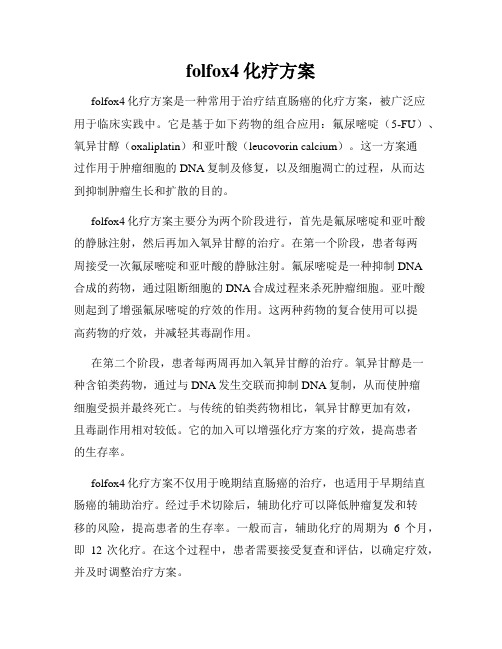
folfox4化疗方案folfox4化疗方案是一种常用于治疗结直肠癌的化疗方案,被广泛应用于临床实践中。
它是基于如下药物的组合应用:氟尿嘧啶(5-FU)、氧异甘醇(oxaliplatin)和亚叶酸(leucovorin calcium)。
这一方案通过作用于肿瘤细胞的DNA复制及修复,以及细胞凋亡的过程,从而达到抑制肿瘤生长和扩散的目的。
folfox4化疗方案主要分为两个阶段进行,首先是氟尿嘧啶和亚叶酸的静脉注射,然后再加入氧异甘醇的治疗。
在第一个阶段,患者每两周接受一次氟尿嘧啶和亚叶酸的静脉注射。
氟尿嘧啶是一种抑制DNA合成的药物,通过阻断细胞的DNA合成过程来杀死肿瘤细胞。
亚叶酸则起到了增强氟尿嘧啶的疗效的作用。
这两种药物的复合使用可以提高药物的疗效,并减轻其毒副作用。
在第二个阶段,患者每两周再加入氧异甘醇的治疗。
氧异甘醇是一种含铂类药物,通过与DNA发生交联而抑制DNA复制,从而使肿瘤细胞受损并最终死亡。
与传统的铂类药物相比,氧异甘醇更加有效,且毒副作用相对较低。
它的加入可以增强化疗方案的疗效,提高患者的生存率。
folfox4化疗方案不仅用于晚期结直肠癌的治疗,也适用于早期结直肠癌的辅助治疗。
经过手术切除后,辅助化疗可以降低肿瘤复发和转移的风险,提高患者的生存率。
一般而言,辅助化疗的周期为6个月,即12次化疗。
在这个过程中,患者需要接受复查和评估,以确定疗效,并及时调整治疗方案。
尽管folfox4化疗方案在肿瘤治疗中取得了显著的进展,但仍然存在一些不可忽视的副作用。
常见的副作用包括恶心、呕吐、消化道不适、脱发、感觉异常等。
这些副作用多数是可逆的,但对患者的身体和心理健康造成一定的影响。
因此,在化疗期间,患者需要密切监测并及时报告任何不适症状,以便医生及时调整治疗方案或给予相应的支持治疗。
此外,个体差异也是影响folfox4化疗方案疗效的因素之一。
不同患者对药物的敏感性和耐受性不同,因此需要根据个体情况进行个体化治疗。
朝晖先比卡鲁胺片使用说明

朝晖先比卡鲁胺片【品牌】朝晖先:【用法用量】1.50mg片剂与促黄体生成素释放激素(LHRH)类似物或外科睾丸切除术联合应用于晚期前列腺癌的治疗.(1)成人成年男性包括老年人:一片(50mg),一天一次,用本品治疗应与LHRH类似物或外科睾丸切除术治疗同时开始.(2)儿童:本品禁用于儿童.(3)肾损害对于肾损害的病人无需调整剂量.(4)肝损害对于轻度肝损害的病人无需调整剂量,中重度肝损伤的病人可能发生药物蓄积(见注意事项).2.150mg片剂用于治疗局部晚期﹑无远处转移的前列腺癌患者,这些患者不适宜或不愿接受外科去势术或其他内科治疗.(1)成年男性包括老年人:口服,一天一次,一次一片(150mg).本品应持续服用至少两年或到疾病进展为止.(2)肾损害:对于肾损害的病人无需调整剂量.(3)肝损害:对于轻度肝损害的病人无需调整剂量,中重度肝损伤的病人可能发生药物蓄积(见“注意事项”)【注意事项】1.本品广泛在肝脏代谢.数据表明严重肝损害的病人药物清除可能会减慢,由此可能导致蓄积.所以本品对有中﹑重度肝损害的病人应慎用.2.由于可能出现肝脏改变,应考虑定期进行肝功能检测.主要的改变一般在本品治疗的最初6个月内出现.严重的肝功能改变很少见于本品的治疗(见‘不良反应’).如果出现严重改变应停止本品治疗.3.本品显示抑制细胞色素P450(CYP3A4)活性,因此当与主要由CYP2A4代谢的药物联合应用时应谨慎(见‘禁忌’和‘药物相互作用’节).4.对乳糖敏感的患者应注意本品150mg片剂每片含61mg乳糖,而每日3片50mg的片剂含有183mg乳糖.5.在每日150mg用于治疗局部晚期﹑无远处转移的前列腺癌时,对于出现疾病客观进展伴有PSA升高的患者,应考虑停止用药.6.对驾驶和操作机器能力的影响本品不会影响病人驾驶及操作机器的能力.但应注意,因偶而可能会出现嗜睡,有过此类作用的病人应予以注意.【不良反应】1.50mg每日,用于与促黄体生成素释放激素(LHRH)类似物或外科睾丸切除术联合应用于晚期前列腺癌的治疗:本品一般来说有良好的耐受性,少有因而停药的情况。
前列腺癌药物Xofigo使用说明 (Ra 223 dichloride) Injection

HaoeYou Pharmacy(好医友美国连锁药房)提供专科药物、处方药物、非处方药物、药物配置、药物注射以及各类非住院患者的药物分发、咨询、配送等各项服务。
美国是医药分开的国家,药房全部实行严格的处方药与非处方药分类管理。
对处方药的销售,必须凭美国医生(电子/纸质)处方。
如今国内患者可以依托科技,实现远程的病历交互,由美国医生根据患者病情开具电子处方,以正规渠道在美国药房购买到处方药。
HIGHLIGHTS OF PRESCRIBING INFORMATION -----------------------WARNINGS AND PRECAUTIONS ---------------------These highlights do not include all the information needed to use XOFIGO safely and effectively. See full prescribing information for XOFIGO.Xofigo (radium Ra 223 dichloride) Injection, for intravenous useInitial U.S. Approval: 2013---------------------------INDICATIONS AND USAGE --------------------------Xofigo is an alpha particle-emitting radioactive therapeutic agent indicated for the treatment of patients with castration-resistant prostate cancer, symptomatic bone metastases and no known visceral metastatic disease. (1)----------------------DOSAGE AND ADMINISTRATION ---------------------The dose regimen of Xofigo is 50 kBq (1.35 microcurie) per kg body weight, given at 4 week intervals for 6 injections. (2.1)---------------------DOSAGE FORMS AND STRENGTHS -------------------Single-use vial at a concentration of 1,000 kBq/mL (27 microcurie/mL) at the reference date with a total radioactivity of 6,000 kBq/vial (162microcurie/vial) at the reference date (3)------------------------------CONTRAINDICATIONS ----------------------------Pregnancy (4, 8.1)FULL PRESCRIBING INFORMATION: CONTENTS*1 INDICATIONS AND USAGE2 DOSAGE AND ADMINISTRATION2.1 Recommended Dosage2.2 Administration2.3 Instructions for Use / Handling3 DOSAGE FORMS AND STRENGTHS4 CONTRAINDICATIONS5 WARNINGS AND PRECAUTIONS5.1 Bone Marrow Suppression6 ADVERSE REACTIONS6.1 Clinical Trials Experience7 DRUG INTERACTIONS8 USE IN SPECIFIC POPULATIONS8.1 Pregnancy8.3 Nursing Mothers8.4 Pediatric Use8.5 Geriatric UseBone Marrow Suppression: Measure blood counts prior to treatment initiation and before every dose of Xofigo. Discontinue Xofigo if hematologic values do not recover within 6 to 8 weeks after treatment. Monitor patients withcompromised bone marrow reserve closely. Discontinue Xofigo in patientswho experience life-threatening complications despite supportive caremeasures. (5.1)------------------------------ADVERSE REACTIONS ----------------------------The most common adverse drug reactions (≥10%) in patients receivingXofigo were nausea, diarrhea, vomiting, and peripheral edema.The most common hematologic laboratory abnormalities (≥10%) wereanemia, lymphocytopenia, leukopenia, thrombocytopenia, and neutropenia(6.1).To report SUSPECTED ADVERSE REACTIONS, contact BayerHealthCare Pharmaceuticals Inc. at 1-888-842-2937 or FDA at 1-800FDA-1088 or /medwatchSEE 17 FOR PATIENT COUNSELING INFORMATIONRevised: 05/20138.6 Patients with Hepatic Impairment8.7 Patients with Renal Impairment8.8 Males of Reproductive Potential10 OVERDOSAGE11 DESCRIPTION12 CLINICAL PHARMACOLOGY12.1 Mechanism of Action12.2 Pharmacodynamics12.3 Pharmacokinetics12.6 Cardiac Electrophysiology13 NONCLINICAL TOXICOLOGY13.1 Carcinogenesis, Mutagenesis, Impairment of Fertility14 CLINICAL STUDIES15 REFERENCES16 HOW SUPPLIED/STORAGE AND HANDLING17 PATIENT COUNSELING INFORMATION*Sections or subsections omitted from the full prescribing information are not listed.FULL PRESCRIBING INFORMATION1 INDICATIONS AND USAGEXofigo is indicated for the treatment of patients with castration-resistant prostate cancer, symptomatic bone metastases and no known visceral metastatic disease.2 DOSAGE AND ADMINISTRATION2.1 Recommended DosageThe dose regimen of Xofigo is 50 kBq (1.35 microcurie) per kg body weight, given at 4 week intervals for 6 injections. Safety and efficacy beyond 6 injections with Xofigo have not been studied.The volume to be administered to a given patient should be calculated using the:•Patient’s body weight (kg)•Dosage level 50 kBq/kg body weight or 1.35 microcurie/kg body weight•Radioactivity concentration of the product (1,000 kBq/mL; 27 microcurie/mL) at the reference date•Decay correction factor to correct for physical decay of radium-223.The total volume to be administered to a patient is calculated as follows:Body weight in kg ×50 kBq/kg body weightVolume to be administered (mL) =Decay factor ×1,000 kBq/mLorBody weight in kg ×1.35 microcurie/kg body weightVolume to be administered (mL) =Decay factor ×27 microcurie/mLTable 1: Decay Correction Factor TableDays from Reference Date Decay Factor Days from Reference Date Decay Factor -14 2.296 0 0.982-13 2.161 1 0.925-12 2.034 2 0.870-11 1.914 3 0.819-10 1.802 4 0.771-9 1.696 5 0.725-8 1.596 6 0.683-7 1.502 7 0.643-6 1.414 8 0.605-5 1.330 9 0.569-4 1.252 10 0.536-3 1.178 11 0.504-2 1.109 12 0.475-1 1.044 13 0.44714 0.420The Decay Correction Factor Table is corrected to 12 noon Central Standard Time (CST). To determine the decay correction factor, count the number of days before or after the reference date. The Decay Correction Factor Table includes a correction to account for the 7 hour time difference between 12 noon Central European Time (CET) at the site of manufacture and 12 noon US CST, which is 7 hours earlier than CET. Immediately before and after administration, the net patient dose of administered Xofigo should be determined by measurement in an appropriate radioisotope dose calibrator that has been calibrated with a National Institute of Standards and Technology (NIST) traceable radium-223 standard (available upon request from Bayer) and corrected for decay using the date and time of calibration. The dose calibrator must be calibrated with nationally recognized standards, carried out at the time of commissioning, after any maintenance procedure that could affect the dosimetry and at intervals not to exceed one year.2.2 AdministrationAdminister Xofigo by slow intravenous injection over 1 minute.Flush the intravenous access line or cannula with isotonic saline before and after injection of Xofigo.2.3 Instructions for Use/HandlingGeneral warningXofigo (an alpha particle-emitting pharmaceutical) should be received, used and administered only by authorized persons in designated clinical settings. The receipt, storage, use, transfer and disposal Xofigo are subject to the regulations and/or appropriate licenses of the competent official organization.Xofigo should be handled by the user in a manner which satisfies both radiation safety and pharmaceutical quality requirements. Appropriate aseptic precautions should be taken.Radiation protectionThe administration of Xofigo is associated with potential risks to other persons (e.g., medical staff, caregivers and patient’s household members) from radiation or contamination from spills of bodily fluids such as urine, feces, or vomit. Therefore, radiation protection precautions must be taken in accordance with national and local regulations.For drug handlingFollow the normal working procedures for the handling of radiopharmaceuticals and use universal precautions for handling and administration such as gloves and barrier gowns when handling blood and bodily fluids to avoid contamination. In case of contact with skin or eyes, the affected area should be flushed immediately with water. In the event of spillage of Xofigo, the local radiation safety officer should be contacted immediately to initiate the necessary measurements and required procedures to decontaminate the area. A complexing agent such as 0.01 M ethylene-diaminetetraacetic acid (EDTA) solution is recommended to remove contamination.For patient careWhenever possible, patients should use a toilet and the toilet should be flushed several times after each use. When handling bodily fluids, simply wearing gloves and hand washing will protect caregivers. Clothing soiled with Xofigo or patient fecal matter or urine should be washed promptly and separately from other clothing.Radium-223 is primarily an alpha emitter, with a 95.3% fraction of energy emitted as alpha-particles. The fraction emitted as beta-particles is 3.6%, and the fraction emitted as gamma-radiation is 1.1%. The external radiation exposure associated with handling of patient doses is expected to be low, because the typical treatment activity will be below 8,000 kBq (216 microcurie). In keeping with the A s L ow A s R easonably A chievable (ALARA) principle for minimization of radiation exposure, it is recommended to minimize the time spent in radiation areas, to maximize the distance to radiation sources, and to use adequate shielding. Any unused product or materials used in connection with the preparation or administration are to be treated as radioactive waste and should be disposed of in accordance with local regulations.The gamma radiation associated with the decay of radium-223 and its daughters allows for the radioactivity measurement of Xofigo and the detection of contamination with standard instruments.Instructions for preparationParenteral drug products should be inspected visually for particulate matter and discoloration prior to administration, whenever solution and container permit.Xofigo is a ready-to-use solution and should not be diluted or mixed with any solutions. Each vial is for single use only.DosimetryThe absorbed radiation doses in major organs were calculated based on clinical biodistribution data in five patients with castration-resistant prostate cancer. Calculations of absorbed radiation doses were performed using OLINDA/EXM(O rgan L evel IN ternal D ose A ssessment/EX ponential M odeling), a software program based on the Medical Internal Radiation Dose (MIRD) algorithm, which is widely used for established beta and gamma emitting radionuclides. For radium-223, which is primarily an alpha particle-emitter, assumptions were made for intestine, red marrow andbone/osteogenic cells to provide the best possible absorbed radiation dose calculations for Xofigo, considering its observed biodistribution and specific characteristics.The calculated absorbed radiation doses to different organs are listed in Table 2. The organs with highest absorbed radiation doses were bone (osteogenic cells), red marrow, upper large intestine wall, and lower large intestine wall. The calculated absorbed doses to other organs are lower.Table 2: Calculated Absorbed Radiation Doses to OrgansTarget Organ Mean(Gy/MBq)Mean(rad/mCi)Coefficient ofVariation(%)Adrenals 0.00012 0.44 56Brain 0.00010 0.37 80Breasts 0.00005 0.18 120Gallbladder wall 0.00023 0.85 14LLI1 Wall 0.04645 171.88 83Small intestine wall 0.00726 26.87 45Stomach wall 0.00014 0.51 22ULI2 wall 0.03232 119.58 50Heart wall 0.00173 6.40 42Kidneys 0.00320 11.86 36Liver 0.00298 11.01 36Lungs 0.00007 0.27 90Muscle 0.00012 0.44 41Ovaries 0.00049 1.80 40Pancreas 0.00011 0.41 43Red marrow 0.13879 513.51 41Osteogenic cells 1.15206 4262.60 41Skin 0.00007 0.27 79Spleen 0.00009 0.33 54Testes 0.00008 0.31 59Thymus 0.00006 0.21 109Thyroid 0.00007 0.26 96Urinary bladder wall 0.00403 14.90 63Uterus 0.00026 0.94 28Whole body 0.02311 85.50 161LLI: lower large intestine2ULI: upper large intestine3 DOSAGE FORMS AND STRENGTHSXofigo (radium Ra 223 dichloride injection) is available in single-use vials containing 6 mL of solution at a concentration of 1,000 kBq/mL (27 microcurie/mL) at the reference date with a total radioactivity of 6,000 kBq/vial (162microcurie/vial) at the reference date.4 CONTRAINDICATIONSXofigo is contraindicated in pregnancy.Xofigo can cause fetal harm when administered to a pregnant woman based on its mechanism of action. Xofigo is not indicated for use in women. Xofigo is contraindicated in women who are or may become pregnant. If this drug is used during pregnancy, or if the patient becomes pregnant while taking this drug, apprise the patient of the potential hazard to the fetus [see Use in Specific Populations (8.1)].5 WARNINGS AND PRECAUTIONS5.1 Bone Marrow SuppressionIn the randomized trial, 2% of patients on the Xofigo arm experienced bone marrow failure or ongoing pancytopenia compared to no patients treated with placebo. There were two deaths due to bone marrow failure and for 7 of 13 patients treated with Xofigo, bone marrow failure was ongoing at the time of death. Among the 13 patients who experienced bone marrow failure, 54% required blood transfusions. Four percent (4%) of patients on the Xofigo arm and 2% on the placebo arm permanently discontinued therapy due to bone marrow suppression.In the randomized trial, deaths related to vascular hemorrhage in association with myelosuppression were observed in 1% of Xofigo-treated patients compared to 0.3% of patients treated with placebo. The incidence of infection-related deaths (2%), serious infections (10%), and febrile neutropenia (<1%) were similar for patients treated with Xofigo and placebo. Myelosuppression; notably thrombocytopenia, neutropenia, pancytopenia, and leukopenia; has been reported in patients treated with Xofigo. In the randomized trial, complete blood counts (CBCs) were obtained every 4 weeks prior to each dose and the nadir CBCs and times of recovery were not well characterized. In a separate single-dose phase 1 study of Xofigo, neutrophil and platelet count nadirs occurred 2 to 3 weeks after Xofigo administration at doses that were up to 1 to 5 times the recommended dose, and most patients recovered approximately 6 to 8 weeks after administration [see Adverse Reactions (6)].Hematologic evaluation of patients must be performed at baseline and prior to every dose of Xofigo. Before the first administration of Xofigo, the absolute neutrophil count(ANC)should be≥1.5 x 109/L,the platelet count ≥100 x 109/L and hemoglobin ≥10 g/dL. Before subsequent administrations of Xofigo, the ANC should be ≥ 1 x109/L and the platelet count≥50x 109/L. If there is no recovery to these values within 6 to 8 weeks after the last administration of Xofigo, despite receiving supportive care, further treatment with Xofigo should be discontinued. Patients with evidence of compromised bone marrow reserve should be monitored closely and provided with supportive care measures when clinically indicated. Discontinue Xofigo in patients who experience life-threatening complications despite supportive care for bone marrow failure.The safety and efficacy of concomitant chemotherapy with Xofigo have not been established. Outside of a clinical trial, concomitant use with chemotherapy is not recommended due to the potential for additive myelosuppression. If chemotherapy, other systemic radioisotopes or hemibody external radiotherapy are administered during the treatment period, Xofigo should be discontinued.6 ADVERSE REACTIONSThe following serious adverse reactions are discussed in greater detail in another section of the label:•Bone Marrow Suppression [see Warnings and Precautions (5.1)]6.1 Clinical Trials ExperienceBecause clinical trials are conducted under widely varying conditions, adverse reaction rates observed in the clinical trials of a drug cannot be directly compared to rates in the clinical trials of another drug and may not reflect the rates observed in practice.In the randomized clinical trial in patients with metastatic castration-resistant prostate cancer with bone metastases, 600 patients received intravenous injections of 50 kBq/kg (1.35 microcurie/kg) of Xofigo and best standard of care and 301 patients received placebo and best standard of care once every 4 weeks for up to 6 injections. Prior to randomization, 58% and 57% of patients had received docetaxel in the Xofigo and placebo arms, respectively. The median duration of treatment was 20 weeks (6 cycles) for Xofigo and 18 weeks (5 cycles) for placebo.The most common adverse reactions (≥10%) in patients receiving Xofigo were nausea, diarrhea, vomiting, and peripheral edema (Table 3). Grade 3 and 4 adverse events were reported among 57% of Xofigo-treated patients and 63% of placebo-treated patients. The most common hematologic laboratory abnormalities in Xofigo-treated patients (≥10%) were anemia, lymphocytopenia, leukopenia, thrombocytopenia, and neutropenia (Table 4).Treatment discontinuations due to adverse events occurred in 17% of patients who received Xofigo and 21% of patients who received placebo. The most common hematologic laboratory abnormalities leading to discontinuation for Xofigo were anemia (2%) and thrombocytopenia (2%).Table 3 shows adverse reactions occurring in≥2% of patients and for which the incidence for Xofigo exceeds the incidence for placebo.Table 3: Adverse Reactions in the Randomized TrialSystem/Organ Class Preferred TermXofigo (n=600) Placebo (n=301) Grades 1-4%Grades 3-4%Grades 1-4%Grades 3-4%Blood and lymphatic system disordersPancytopenia 2 1 0 0 Gastrointestinal disordersNausea 36 2 35 2 Diarrhea 25 2 15 2 Vomiting 19 2 14 2 General disorders and administration site conditionsPeripheral edema 13 2 10 1 Renal and urinary disordersRenal failure andimpairment3 1 1 1Laboratory AbnormalitiesTable 4 shows hematologic laboratory abnormalities occurring in > 10% of patients and for which the incidence for Xofigo exceeds the incidence for placebo.Table 4: Hematologic Laboratory AbnormalitiesHematologic Xofigo (n=600) Placebo (n=301)Laboratory Abnormalities Grades 1-4%Grades 3-4%Grades 1-4%Grades 3-4%Anemia 93 6 88 6 Lymphocytopenia 72 20 53 7 Leukopenia 35 3 10 <1 Thrombocytopenia 31 3 22 <1 Neutropenia 18 2 5 <1 Laboratory values were obtained at baseline and prior to each 4-week cycle.As an adverse reaction, grade 3-4 thrombocytopenia was reported in 6% of patients on Xofigo and in 2% of patients on placebo. Among patients who received Xofigo, the laboratory abnormality grade 3-4 thrombocytopenia occurred in 1% of docetaxel naïve patients and in 4% of patients who had received prior docetaxel. Grade 3-4 neutropenia occurred in 1% of docetaxel naïve patients and in 3% of patients who have received prior docetaxel.Fluid StatusDehydration occurred in 3% of patients on Xofigo and 1% of patients on placebo. Xofigo increases adverse reactions such as diarrhea, nausea, and vomiting which may result in dehydration. Monitor patients’ oral intake and fluid status carefully and promptly treat patients who display signs or symptoms of dehydration or hypovolemia.Injection Site ReactionsErythema, pain, and edema at the injection site were reported in 1% of patients on Xofigo.Secondary Malignant NeoplasmsXofigo contributes to a patient’s overall long-term cumulative radiation exposure. Long-term cumulative radiation exposure may be associated with an increased risk of cancer and hereditary defects. Due to its mechanism of action and neoplastic changes, including osteosarcomas, in rats following administration of radium-223 dichloride, Xofigo may increase the risk of osteosarcoma or other secondary malignant neoplasms [see Nonclinical Toxicology (13.1)]. However, the overall incidence of new malignancies in the randomized trial was lower on the Xofigo arm compared to placebo (<1% vs. 2%; respectively), but the expected latency period for the development of secondary malignancies exceeds the duration of follow up for patients on the trial.Subsequent Treatment with Cytotoxic ChemotherapyIn the randomized clinical trial, 16% patients in the Xofigo group and 18% patients in the placebo group received cytotoxic chemotherapy after completion of study treatments. Adequate safety monitoring and laboratory testing was not performed to assess how patients treated with Xofigo will tolerate subsequent cytotoxic chemotherapy.7 DRUG INTERACTIONSNo formal clinical drug interaction studies have been performed.Subgroup analyses indicated that the concurrent use of bisphosphonates or calcium channel blockers did not affect the safety and efficacy of Xofigo in the randomized clinical trial.8 USE IN SPECIFIC POPULATIONS8.1 Pregnancy Category X [see Contraindications (4)]Xofigo can cause fetal harm when administered to a pregnant woman based on its mechanism of action. While there are no human or animal data on the use of Xofigo in pregnancy and Xofigo is not indicated for use in women, maternal use of a radioactive therapeutic agent could affect development of a fetus. Xofigo is contraindicated in women who are or may become pregnant while receiving the drug. If this drug is used during pregnancy, or if the patient becomes pregnant while taking this drug, apprise the patient of the potential hazard to the fetus and the potential risk for pregnancy loss. Advise females of reproductive potential to avoid becoming pregnant during treatment with Xofigo.8.3 Nursing MothersXofigo is not indicated for use in women. It is not known whether radium-223 dichloride is excreted in human milk. Because many drugs are excreted in human milk, and because of potential for serious adverse reactions in nursing infants from Xofigo, a decision should be made whether to discontinue nursing, or discontinue the drug taking into account the importance of the drug to the mother.8.4 Pediatric UseThe safety and efficacy of Xofigo in pediatric patients have not been established.In single-and repeat-dose toxicity studies in rats, findings in the bones (depletion of osteocytes, osteoblasts, osteoclasts, fibro-osseous lesions, disruption/disorganization of the physis/growth line) and teeth (missing, irregular growth, fibroosseous lesions in bone socket) correlated with a reduction of osteogenesis that occurred at clinically relevant doses beginning in the range of 20 – 80 kBq (0.541 -2.16 microcurie) per kg body weight.8.5 Geriatric UseOf the 600 patients treated with Xofigo in the randomized trial, 75% were 65 years of age and over and while 33% were 75 years of age and over. No dosage adjustment is considered necessary in elderly patients. No overall differences in safety or effectiveness were observed between these subjects and younger subjects, and other reported clinical experience has not identified differences in responses between the elderly and younger patients, but greater sensitivity of some older individuals cannot be ruled out.8.6 Patients with Hepatic ImpairmentNo dedicated hepatic impairment trial for Xofigo has been conducted. Since radium-223 is neither metabolized by the liver nor eliminated via the bile, hepatic impairment is unlikely to affect the pharmacokinetics of radium-223 dichloride [see Clinical Pharmacology (12.3)]. Based on subgroup analyses in the randomized clinical trial, dose adjustment is not needed in patients with mild hepatic impairment. No dose adjustments can be recommended for patients with moderate or severe hepatic impairment due to lack of clinical data.8.7 Patients with Renal ImpairmentNo dedicated renal impairment trial for Xofigo has been conducted. Based on subgroup analyses in the randomized clinical trial, dose adjustment is not needed in patients with existing mild (creatinine clearance [CrCl] 60 to 89 mL/min) or moderate (CrCl 30 to 59 mL/min) renal impairment. No dose adjustment can be recommended for patients with severe renal impairment (CrCl less than 30 mL/min) due to limited data available (n = 2) [see Clinical Pharmacology (12.3)]. 8.8 Males of Reproductive PotentialContraceptionBecause of potential effects on spermatogenesis associated with radiation, advise men who are sexually active to use condoms and their female partners of reproductive potential to use a highly effective contraceptive method during and for 6 months after completing treatment with Xofigo.InfertilityThere are no data on the effects of Xofigo on human fertility. There is a potential risk that radiation by Xofigo could impair human fertility [see Nonclinical Toxicology (13.1)].10 OVERDOSAGEThere have been no reports of inadvertent overdosing of Xofigo during clinical studies.There is no specific antidote. In the event of an inadvertent overdose of Xofigo, utilize general supportive measures, including monitoring for potential hematological and gastrointestinal toxicity, and consider using medical countermeasures such as aluminum hydroxide, barium sulfate, calcium carbonate, calcium gluconate, calcium phosphate, or sodium alginate.1Single Xofigo doses up to 250 kBq (6.76 microcurie) per kg body weight were evaluated in a phase 1 clinical trial and no dose-limiting toxicities were observed.11 DESCRIPTIONRadium Ra 223 dichloride, an alpha particle-emitting pharmaceutical, is a radiotherapeutic drug.Xofigo is supplied as a clear, colorless, isotonic, and sterile solution to be administered intravenously with pH between 6 and 8.Each milliliter of solution contains 1,000 kBq radium-223 dichloride (27 microcurie), corresponding to 0.53 ng radium223, at the reference date. Radium is present in the solution as a free divalent cation.Each vial contains 6 mL of solution (6,000 kBq (162 microcurie) radium-223 dichloride at the reference date). The inactive ingredients are 6.3 mg/mL sodium chloride USP (tonicity agent), 7.2 mg/mL sodium citrate USP (for pH adjustment), 0.2 mg/mL hydrochloric acid USP (for pH adjustment), and water for injection USP.The molecular weight of radium-223 dichloride, 223RaCl2, is 293.9 g/mol.Radium-223 has a half-life of 11.4 days. The specific activity of radium-223 is 1.9 MBq (51.4 microcurie)/ng.The six-stage-decay of radium-223 to stable lead-207 occurs via short-lived daughters, and is accompanied predominantly by alpha emissions. There are also beta and gamma emissions with different energies and emission probabilities. The fraction of energy emitted from radium-223 and its daughters as alpha-particles is 95.3% (energy range of 5 -7.5 MeV). The fraction emitted as beta-particles is 3.6% (average energies are 0.445 MeV and 0.492 MeV), and the fraction emitted as gamma-radiation is 1.1% (energy range of 0.01 -1.27 MeV).12 CLINICAL PHARMACOLOGY12.1 Mechanism of ActionThe active moiety of Xofigo is the alpha particle-emitting isotope radium-223 (as radium Ra 223 dichloride), which mimics calcium and forms complexes with the bone mineral hydroxyapatite at areas of increased bone turnover, such as bone metastases (see Table 2). The high linear energy transfer of alpha emitters (80 keV/micrometer) leads to a high frequency of double-strand DNA breaks in adjacent cells, resulting in an anti-tumor effect on bone metastases. The alpha particle range from radium-223 dichloride is less than 100 micrometers (less than 10 cell diameters) which limits damage to the surrounding normal tissue.12.2 PharmacodynamicsCompared with placebo, there was a significant difference in favor of Xofigo for all five serum biomarkers for bone turnover studied in a phase 2 randomized study (bone formation markers: bone alkaline phosphatase [ALP], total ALP and procollagen I N propeptide [PINP], bone resorption markers: C-terminal crosslinking telopeptide of type I collagen [S-CTX-I] and type I collagen crosslinked C-telopeptide [ICTP]).12.3 PharmacokineticsThe pharmacokinetics of radium-223 dichloride in blood was linear in terms of dose proportionality and time independence in the dose range investigated (46 to 250 kBq [1.24 to 6.76 microcurie] per kg body weight). DistributionAfter intravenous injection, radium-223 is rapidly cleared from the blood and is distributed primarily into bone or is excreted into intestine. Fifteen minutes post-injection, about 20% of the injected radioactivity remained in blood. At 4 hours, about 4% of the injected radioactivity remained in blood, decreasing to less than 1% at 24 hours after the injection. At 10 minutes post-injection, radioactivity was observed in bone and in intestine. At 4 hours post-injection, the percentage of the radioactive dose present in bone and intestine was approximately 61% and 49%, respectively. No significant uptake。
晚期前列腺癌药物Xofigo(Ra 223 dichloride)

单次使用小瓶浓度 1,000 kBq/mL(27 微居里/mL)在参比日期有总放射性 6,000 kBq/小瓶(162 微居里/vial)在参比日期。
用法用量
在跨越 1 分钟缓慢静脉注射给予 Xofigo。注射 Xofigo 前和后用等张盐水冲洗静脉注取线或 插管。Xofigo 的给药方案是 50 kBq (1.35 微居里)每 kg 体重,给予 4 周间隔共 6 次注射。
关于 CRPC 和骨转移
骨骼是体内转移性癌症影响的最常见部位,前列腺癌的骨转移尤其普遍。转移性前列腺癌中 有约 90%的患者发生骨转移。骨转移能够导致增加骨骼事件的发生频率,并已被证明是 CRPC 患者发病和致死的主要病因。
前列腺癌是世界范围内男性中最常见的非皮肤恶性肿瘤。2008 年,世界范围内据估算有 899,000 名男性被诊断患前列腺癌,其中 258,000 名死于该疾病。前列腺癌是男性癌症的第 6 位死亡原因。
预先指定总体生存中期分析揭示接受 XOFIGO 加最佳标准医护患者与接受安慰剂加最佳标 准医护患者比较统计显著改善。患者交叉与另外 214 事件前进行一项探索性更新总体生存 分析导致发现与中期分析一致。
作用机制
Xofigo 的活性部位是α 粒子发射同位素镭-223(为二氯化镭 223),模拟钙和在骨更新增加区 与骨矿物质 hydroxyapatite 形成复合物,例如骨转移(见表 2)。α发射体的高线性能量转移(80 keV/微米)导致在临近细胞中双链 DNA 的高频断裂,导致对骨转移的抗肿瘤作用。来自二氯 化镭-223 的α粒子范围小于 100 微米(小于 10 个细胞直径)限制对周围正常组织损伤。
概述
Xofigo 是获 FDA 批准的首个α-粒子辐射放射性治疗药物。在关键性 go 显着改善了整体存活率(OS),同时延迟了首次有症状骨 骼事件(SSE)的发生时间。
前列腺癌去势药物诺雷得三月长效剂型在中国上市
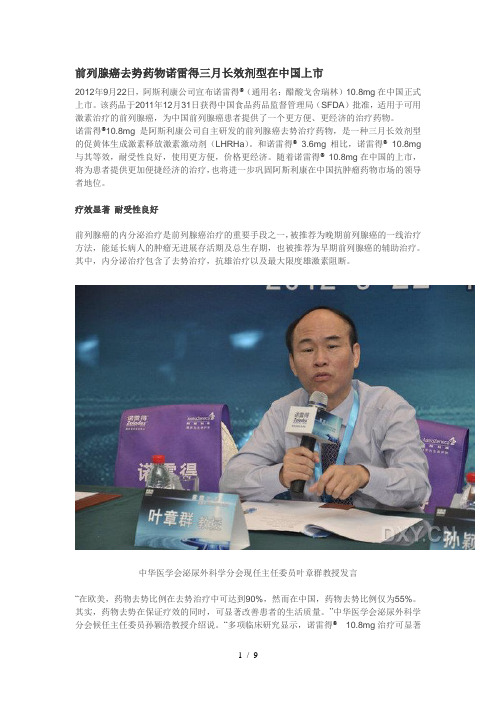
前列腺癌去势药物诺雷得三月长效剂型在中国上市2012年9月22日,阿斯利康公司宣布诺雷得®(通用名:醋酸戈舍瑞林)10.8mg在中国正式上市。
该药品于2011年12月31日获得中国食品药品监督管理局(SFDA)批准,适用于可用激素治疗的前列腺癌,为中国前列腺癌患者提供了一个更方便、更经济的治疗药物。
诺雷得®10.8mg是阿斯利康公司自主研发的前列腺癌去势治疗药物,是一种三月长效剂型的促黄体生成激素释放激素激动剂(LHRHa)。
和诺雷得®3.6mg相比,诺雷得®10.8mg 与其等效,耐受性良好,使用更方便,价格更经济。
随着诺雷得®10.8mg在中国的上市,将为患者提供更加便捷经济的治疗,也将进一步巩固阿斯利康在中国抗肿瘤药物市场的领导者地位。
疗效显著耐受性良好前列腺癌的内分泌治疗是前列腺癌治疗的重要手段之一,被推荐为晚期前列腺癌的一线治疗方法,能延长病人的肿瘤无进展存活期及总生存期,也被推荐为早期前列腺癌的辅助治疗。
其中,内分泌治疗包含了去势治疗,抗雄治疗以及最大限度雄激素阻断。
中华医学会泌尿外科学分会现任主任委员叶章群教授发言“在欧美,药物去势比例在去势治疗中可达到90%,然而在中国,药物去势比例仅为55%。
其实,药物去势在保证疗效的同时,可显著改善患者的生活质量。
”中华医学会泌尿外科学分会候任主任委员孙颖浩教授介绍说。
“多项临床研究显示,诺雷得®10.8mg治疗可显著降低睾酮水平至去势范围并持续抑制,并显著降低血清PSA水平,与诺雷得®3.6mg相当而且耐受性良好。
”中华医学会泌尿外科学分会现任主任委员叶章群教授认为。
更多的患者将从诺雷得®10.8mg中受益对于患者来说,诺雷得®使用方便,减少了注射次数,三个月才需到医院进行一次皮下注射,既能保持有效的血药浓度,且无组织蓄积,其他时间均可像正常人一样生活、工作,不仅减轻了患者的负担,而且每月治疗费用还能节省23%,这都有助于保证依从性,是前列腺癌药物去势治疗的首选。
- 1、下载文档前请自行甄别文档内容的完整性,平台不提供额外的编辑、内容补充、找答案等附加服务。
- 2、"仅部分预览"的文档,不可在线预览部分如存在完整性等问题,可反馈申请退款(可完整预览的文档不适用该条件!)。
- 3、如文档侵犯您的权益,请联系客服反馈,我们会尽快为您处理(人工客服工作时间:9:00-18:30)。
作用机制
Xofigo 的活性部位是α 粒子发射同位素镭-223(为二氯化镭 223),模拟钙和在骨更新增加区 与骨矿物质 hydroxyapatite 形成复合物,例如骨转移(见表 2)。α发射体的高线性能量转移(80 keV/微米)导致在临近细胞中双链 DNA 的高频断裂,导致对骨转移的抗肿瘤作用。来自二氯 化镭-223 的α粒子范围小于 100 微米(小于 10 个细胞直径)限制对周围正常组织损伤。
大多数患 CRPC 的男性有骨转移的放射学证据。一旦癌症细胞定殖于骨骼,它们即可干扰 骨强度,常常导致疼痛、骨折和可能明显损害男性健康的其它并发症。继发于前列腺癌的骨 转移一般以腰椎、椎骨和骨盆为靶区。事实上,骨转移是 CRPC 患者中发病和死亡的主要 原因。
适应症和用途
Xofigo 是一种α粒子发射放射性治疗药物适用为有去势耐受前列腺癌,症状性骨转移和无已 知内脏转移病患者的治疗。
禁忌证
妊娠,Xofigo 当给予妊娠妇女根据其作用机制可致胎儿危害。Xofigo 不适用妊娠或可能成 为妊娠妇女禁忌 Xofigo。如妊娠期间使用药物,或如患者当服用药物成为妊娠,忠告患者 对胎儿潜在危害。
不良反应
Xofigo 治疗组病人出现的最常见的(≥10%)不良反应为恶心、腹泻、呕吐、外周水肿;最 常见的(≥10%)血液学实验室检查异常(图 3)为贫血、淋巴细胞减少、白细胞减少、血 小板减少、中性粒细胞减少。2%的 Xofigo 治疗组病人出现了骨髓功能衰竭和进行性全血细 胞减少症。
商用名:Xofigo 通用名:Ra 223 dichloride 中文名:二氯化镭 223 批准时间:2013 年 剂型或给药途径:溶解,静脉 化学类型:New molecular entity (NME) 活性成分:RADIUM RA-223 DICHLORIDE 包装规格:162mCi/6ML (27mCi/ML) 批准文号:NDC 50419-208-01 生产厂商:拜耳(Bayer) 用药指导:好医友(Haoeyou Healthcare)
概述
Xofigo 是获 FDLSYMPCA 临床 试验中,与安慰剂相比,Xofigo 显着改善了整体存活率(OS),同时延迟了首次有症状骨 骼事件(SSE)的发生时间。
临床试验中,Xofigo 表现出了良好的安全性,该药以一种完全新颖的方式改善患者的预后。 镭 233 发射的α粒子能够作用于骨转移的癌细胞,能够帮助改善患者的生存。
预先指定总体生存中期分析揭示接受 XOFIGO 加最佳标准医护患者与接受安慰剂加最佳标 准医护患者比较统计显著改善。患者交叉与另外 214 事件前进行一项探索性更新总体生存 分析导致发现与中期分析一致。
在预先计划中期分析截止日期,总共 809 例患者已被随机化 2:1 至接受 Xofigo 50 kBq(1.35 微居里)/kg 静脉每 4 周共 6 疗程(n = 541)加最佳标准医护或匹配的安慰剂加最佳标准医护(n = 268)。最佳标准医护包括局部 EBRT,直至不能接受毒性或细胞毒化疗,其他全身放射性 同位素半身 EBRT 或其他研究性药物的开始。研究排除患者有克罗恩病,溃疡性结肠炎,既 往半身辐射或未处理紧迫脊髓压迫。在开始或恢复 Xofigo 治疗前有骨折,整形手术患者进 行稳定化。
剂型和规格
单次使用小瓶浓度 1,000 kBq/mL(27 微居里/mL)在参比日期有总放射性 6,000 kBq/小瓶(162 微居里/vial)在参比日期。
用法用量
在跨越 1 分钟缓慢静脉注射给予 Xofigo。注射 Xofigo 前和后用等张盐水冲洗静脉注取线或 插管。Xofigo 的给药方案是 50 kBq (1.35 微居里)每 kg 体重,给予 4 周间隔共 6 次注射。
患者按基线 ALP,双膦酸盐使用,和既往多西紫杉醇暴露分层。41%患者以前使用双膦酸盐 和 58%既往曾使用多西紫杉醇。在治疗期间,83%的 Xofigo 患者和 82%安慰剂患者接受促 性腺释放激素激动剂[gonadotropin-releasing hormone agonists]和 21%的 Xofigo 患者和 34%安 慰剂患者同时接受抗雄激素。平衡组间使用全身甾体[steroids](41%)和双膦酸盐(40%)。
关于 CRPC 和骨转移
骨骼是体内转移性癌症影响的最常见部位,前列腺癌的骨转移尤其普遍。转移性前列腺癌中 有约 90%的患者发生骨转移。骨转移能够导致增加骨骼事件的发生频率,并已被证明是 CRPC 患者发病和致死的主要病因。
前列腺癌是世界范围内男性中最常见的非皮肤恶性肿瘤。2008 年,世界范围内据估算有 899,000 名男性被诊断患前列腺癌,其中 258,000 名死于该疾病。前列腺癌是男性癌症的第 6 位死亡原因。
注意事项
骨髓抑制:治疗开始前和每剂量 Xofigo 前测量血计数。如治疗后 6 至 8 周内血液学值未恢 复终止 Xofigo。严密监视患者受损骨髓保留。在尽管支持医护措施仍经受危及生命并发症 患者终止 Xofigo。
临床研究
在有症状性骨转移去势耐受前列腺癌患者一项双盲,随机化,安慰剂对照 3 期临床试验评价 Xofigo 的疗效和安全性。患者有内脏转移和恶性淋巴结病变超过 3 cm 被排除。主要疗效终 点是总体生存。一个关键第二疗效终点是至首次症状性骨事件(SSE)被定义为由外放疗束 (EBRT) 至骨骨症状缓解,新症状性病理性骨折,发生脊髓压迫,或肿瘤相关整形手术干预。 对研究未进行计划的放射影像评估。所有患者被基线去除雄激素治疗。
